How to password protect viewing and editing Word documents. What does it mean to protect Microsoft Office and PDF documents with a password?
If you are actively working with text documents, you may be wondering how to protect a Word document. Developers office suite Microsoft Office 2010 provided a number of functions to solve this problem.
We use standard MS Office features
In order to take advantage of the options for protecting a Word document, launch the file menu in the upper left corner of the program window. In the window that opens, select “Information” and click on the “Protect Document” button.
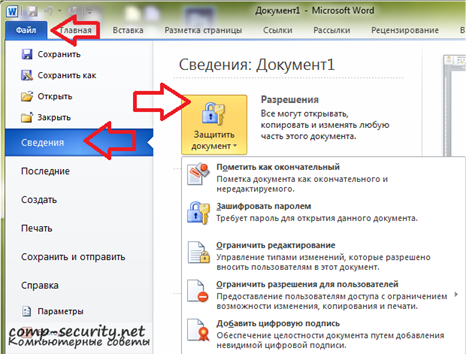
A drop-down menu will open in front of you with the following items:
- Mark as final. Mark the document as final and not editable.
- Encrypt with a password. Requires a password when opening a document.
- Restrict editing. Control the types of changes that users are allowed to make to this document.
- Add a digital signature. Ensuring document integrity by adding invisible digital signature.
Let's consider all these types of document protection in order.
Mark as final. When using this function, the document will become locked for editing. When you open it, a message indicating that editing is prohibited will appear at the top of the window. However, the ban on editing such a document can be removed at any time without having to enter a password.
Encrypt with a password. Using this method to protect a Word document, the user is prompted to enter a password with which to . When you try to open an encrypted document, the program will require input.
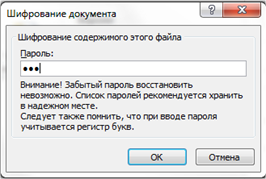
Restrict editing. This mode Document Protection allows you to set restrictions on formatting or editing a document.
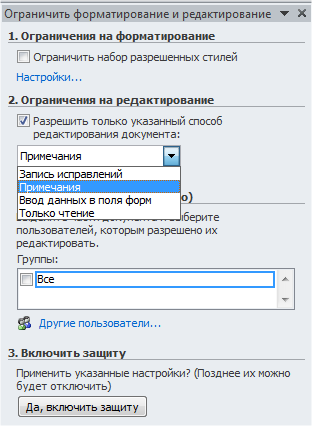
Add a digital signature. This function allows the user to protect their document using a digital signature. This method of protection allows you to verify the authenticity and integrity of the document.
We use other programs
A Word document, like any other file, can be encrypted using third party programs. The best option will . Such archives are supported operating system Windows. This means that they can be opened even without installing an archiver program.
Maybe, . Therefore, let's look at the process of creating an encrypted archive using her example.
Open context menu for the document you want to encrypt and select 7-Zip – Add to archive.
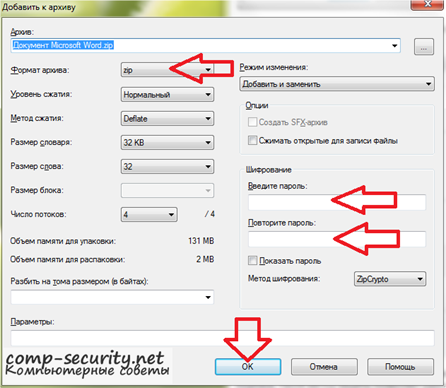
In the window that opens you need. After which the program will create an encrypted archive and save it in the same folder where the original document is located.
Microsoft Office allows you to encrypt office documents and PDF files, preventing anyone from even viewing the file without knowing the password. Modern versions Office uses secure , so you can rely on the protection provided strong password.
The following protection instructions apply to Microsoft Word, PowerPoint, Excel and Access 2016, the process is generally the same as in others latest versions Office.
How strong is password protection in Microsoft Office?
The password protection feature in Microsoft Office had in the past bad reputation . From Office 95 to Office 2003, the encryption scheme was very weak. If you have a document protected in Office 2003 or earlier, the password can be easily and quickly bypassed using widely available password cracking software.
With Office 2007, Microsoft started taking security more seriously. Office 2007 moved to Advanced Encryption Standard (AES) with 128-bit key. It's considered secure, meaning Office now uses real, strong encryption to protect documents when a password is set. PDF in Office 2016 is also based on 128-bit AES encryption.
There are two important points, which need to be remembered. Firstly, only those documents that cannot be opened without a password are reliably protected. Office lets you set a password for an option Restrict Editing, which allows users to view the file but not edit it without a password. This type of password can be easily hacked and removed, allowing the file to be modified.
Secondly, encryption works well if you save the file in modern formats such as .docx. When saving in older formats such as .doc that are compatible with Office 2003 and earlier Office versions, the old, weaker version of encryption will be used.
But if you save files in modern Office formats and using the option instead of Restrict Editing, documents must be safe.
How to password protect an Office document?
To password protect Office document, you must first open it in Word, Excel, PowerPoint, or Access. Select menu File in the upper left corner of the screen. On the panel Intelligence click Document protection and select Encrypt using password.
Button Document protection called this in Microsoft Word, in other applications it will be Book protection(Microsoft Excel) Protecting your presentation(Microsoft PowerPoint), etc.
Note: If you want to limit the ability to edit a document, select here Restrict Editing, but as said, it is not very secure and the protection can be easily bypassed. It's always better to encrypt the entire document.
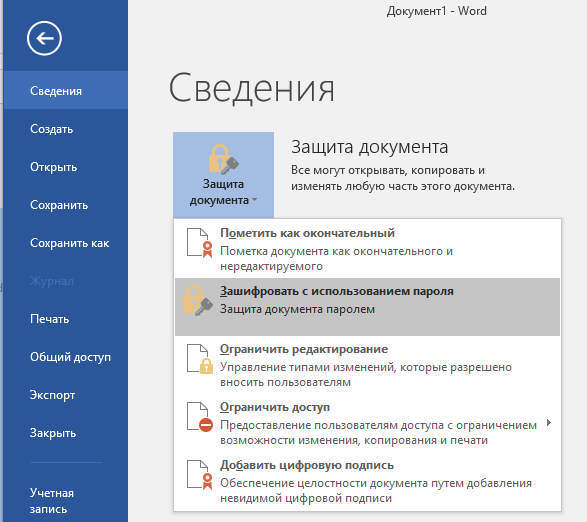 Enter your desired password. Choose a strong password. Weak passwords can be easily cracked using appropriate software.
Enter your desired password. Choose a strong password. Weak passwords can be easily cracked using appropriate software.
Attention: You will lose access to the document if you forget your password! Microsoft recommends writing down the name of the document and its password and storing it in a safe place.
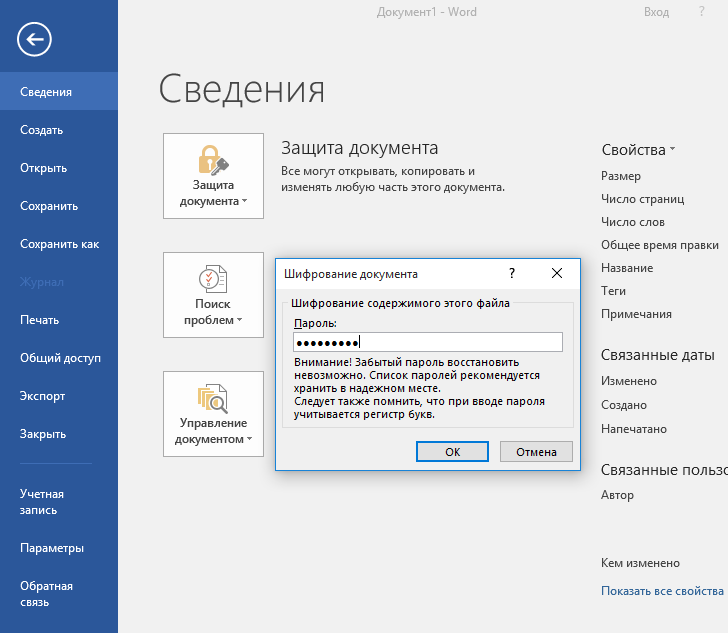
When the document is encrypted, you will see in the menu File In chapter Intelligence message Requires password to open of this document .
The next time you open a file, a message will appear Enter the password to open the file. If you do not enter correct password, you will not be able to view the document at all.
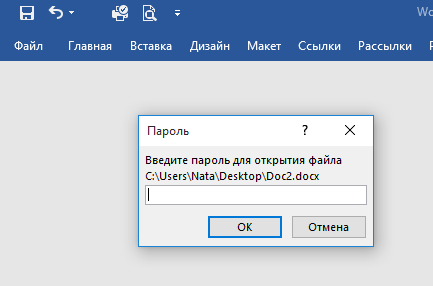
To remove password protection from a document, click Document protection and press again Encrypt using password. Clear the password fields and click the button OK. The password will be removed from the document.
How to create a password protected PDF file?
You can also export an Office document to PDF file and already password protect this PDF file. This can be done in Microsoft Word, Excel and PowerPoint.
To do this, open the document, click the menu button File and select Export. Click the button Create PDF/XPS to export the document to PDF.
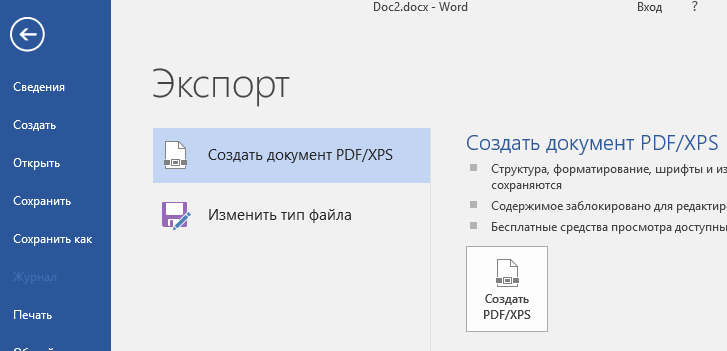
Click on the button Options at the bottom of the dialog box that opens. At the bottom of the settings window you need to enable Encrypt a document with a password and press the button OK.
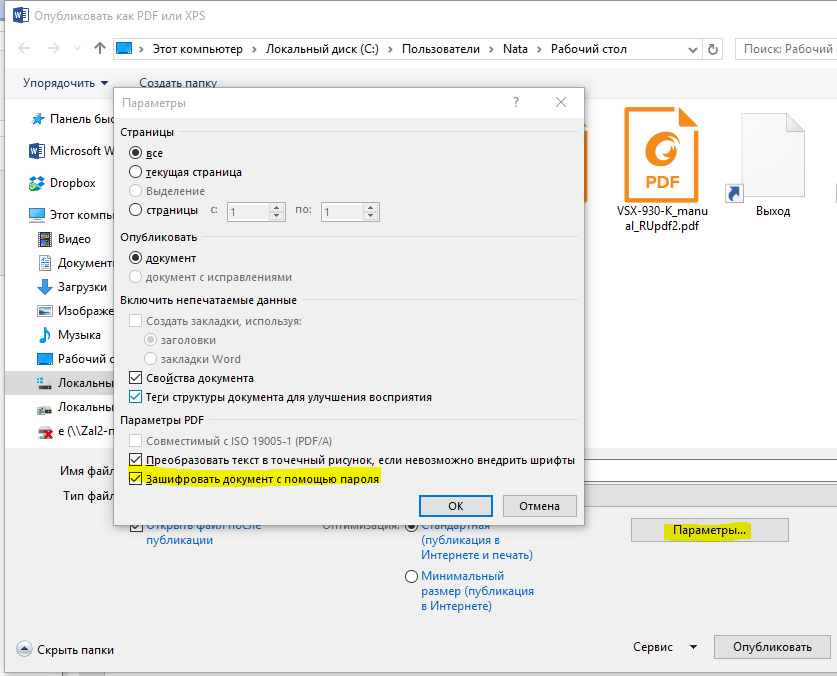
Enter required password, press OK.
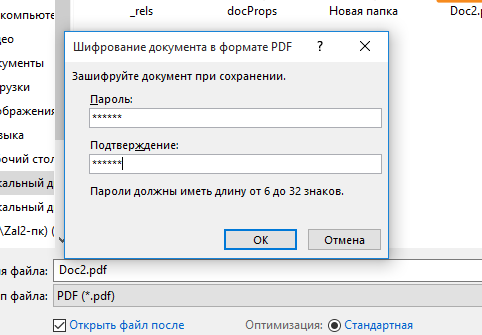
Then enter a name for the PDF file and click Publish. Office exports the document to a password-protected PDF file.
Attention: You will not be able to view the PDF file if you have forgotten your password.
Accordingly, when opening this PDF file in any program for PDF viewer You will be required to enter a password.
In general, the document encryption feature will help protect particularly important documents, especially if they are stored on USB drive or in the service.
Microsoft Word is the most popular text editor in the world. This success is explained by the enormous functionality of this editor and the ease of its implementation. This editor also has its own security system, which we will talk about in this article.
Protecting Microsoft Word Documents
The editor allows you to put your digital signature and password protection into two types of documents:
- Password for document modification
- Password for opening a document
Picture 1
Microsoft Word allows passwords of up to 15 characters. Both passwords are requested when opening the document. If you refuse to enter a password to modify a document, the document opens in reading mode. The password for opening a document is the basis for creating an encryption key, which is encrypted using the RC4 algorithm. You can also install additional degrees protection over the document:
- Recording corrections and entries. All corrections are recorded and noted, after which they can be accepted or rejected by the author or editor of the document.
- Prohibition of changes, except for comments. When viewing a document, you can only add comments.
- Changing the document is prohibited, but you are allowed to enter data into selected forms.
Protecting VBA Modules
The built-in VMA programming language adds capabilities to... huge selection functions in formats Microsoft documents. VBA macros are practically unlimited, since functions can be called from a macro dynamic libraries, which gives access to the computer within the rights of a specific user. Protecting the contents of VBA programs is necessary, for example:
- to preserve the intellectual property that the VBA program has
- to preserve the integrity of this program from modifications
Protecting VBA Modules
The VBA language allows you to create various actions when certain events occur using macros. For Microsoft Word it is:
- AutoOpen - called when a document is opened
- AutoClose – called when the document is closed
- AutoExec – called when Microsoft launch Word
- AutoExit – called when closing Microsoft Word
- AutoNew – called when a new document is created
For example, if a document contains the AutoOpen macro virus, then when this document is opened, the AutoOpen macro code will be automatically executed. Such a macro can be found in a template. Such macros execute their code without the user's knowledge. This principle is used by macro viruses to spread and activate. For example, consider a classic macro virus:
- The macrovirus is contained in the AutoOpen macro of a certain document Doc.xdoc
- When the user opens a document, the macro virus performs functions and also copies itself into the AutoOpen, AutoNew macros of the Doc.xdoc template
- When opening an uninfected document, the macro copies itself to the new document
Microsoft Word offers digital certificates as protection against macro viruses. The implementation of digital certificates is based on the fact that when opening a document that contains VBA modules, a check is implemented electronic signature VBA module. Macros are blocked because their signature will be incorrect.
Microsoft Word document security issues
The security subsystem of Microsoft Word has a number of shortcomings. Starting with passwords, any password protection in comparison with a generated password based on a cryptographic key has a number of disadvantages:
- Users may be careless with passwords and enter common phrases.
- Often used short passwords, which allows for faster brute force attacks.
Security problems are also aggravated by the following aspects:
- RC4 encryption, which is used to encrypt documents, has a key length of up to 128 bits. Microsoft Word limits passwords to 15 characters, which means the password is 9 bytes long. Thus, the effective key length is 2 times less than that provided by the RC4 algorithm.
- Single character passwords can be used
- There are utilities automatic selection password for Microsoft Word.
Lack of real protection for VBA modules
To analyze the protection of VBA modules, it was possible to create a macro in a document that sets the Russian language for the selected fragment:
- Sub Macro()
- Selection.LanguageID = wdRussian
- Selection.NoProofing = False
- Application.CheckLanguage = True
- End Sub
Then a password was set for this document from viewing the contents. Then this document was viewed in the DOS editor, and the following picture was visible:
- SelectionZo0 A ©Ä LanguageIDis0 A ©Ä wdRussian=W0 A ©Ä NoProofing^]0 ÆA ©Ä Applicatione*0 A ©Ä CheckLanguage ¯0 ¨
Apparently missing real protection VBA macro from viewing. The advice is that VBA macros are placed as much as possible in external DLLs.
Small, but extremely useful selection known and frequently used methods of document protection text editor Microsoft Word.
Reading various Russian-language conferences that in one way or another touch on “office” topics, I often come across the same questions from users about ways to protect what they have created. Word documents. Despite the fact that the answer to them is no secret, questions are asked again and again.
In this article, I will describe well-known and frequently used methods for protecting Word documents.
The easiest way to protect your document is to set a password to open the file and/or change it. Go to the "Tools" menu and select the "Options" command. A dialog box will open in which you should go to the "Security" tab.
If you set a password to open a document, then when you try to open this document, a password request window will be displayed. The same window will be displayed if you have set a password to make changes to the file, although with one difference - you can still open the document, but only in read-only mode.
It’s clear what to talk about reliable protection your data is not necessary in these cases. The password can be guessed by some specialized program, and the file opened in read-only mode can be saved under a different name. However, it all depends on the goals of the user who plans to protect his document.
The second point that you should pay attention to when protecting a document is the password. Of course, you can come up with a very long password containing all known characters. You can also use special programs-password generators.
Do you know what Microsoft developers' favorite password is? Password! Yes, that's exactly the word. But they write it in such a way that it is almost impossible to unravel or select by searching. Let me make a reservation right away that I am telling this legend from strangers, so I cannot vouch for its verisimilitude. But the very principle of compiling such passwords deserves attention. So, programmers write the word password like this: p@$$w0rd. Would you have guessed to encrypt a word like this?
You can make the task even more difficult for a potential attacker by strengthening document protection with password encryption. The default encryption algorithm is simple. But you can choose a more complex and advanced type of encryption if, on the same “Security” tab of the Document Options window, you click on the “Advanced” button.
Another, very similar way to protect document data is to prohibit any changes to the document, except for making corrections to the document, inserting notes, or entering data in form fields. In the "Tools" menu, select the "Install protection" command. The dialog box shown in the following screenshot will open (this is how it looks in Word 2002):
In this window, you can set a ban on all changes to the document, except for the above actions.
IN Word versions 2003 document protection capabilities have been expanded and improved. Instead of the "Document Protection" dialog box, the "Document Protection" task pane will be displayed on the right side of the editor's working window. With the help available options in the task area you can restrict users from their attempts to change the formatting of the document, edit the document. In order for your bans to take effect, you must click the “Enable protection” button in the task area. You will be prompted to enter your password. And whenever the user tries to turn off document protection, given password will be requested.
Other interesting opportunity concerns your personal data. It is no secret that when documents are created, they store the names of the authors or editors of the document, information about working together, some other information hidden in the document. By standard means Word can only get rid of personal information stored in file properties. Other data remains unchanged in the document.
For such cases, Microsoft has developed a special program, positioned as “Office 2003/XP Add-in: Hidden Data Removal Tool.” Computerra-Online talked about this utility back in March 2005. You can download this program from the official Microsoft website.
How to protect data in template forms from unwanted changes was also discussed in great detail in the material by Nadezhda Balovsyak.
When we talk about protecting Word documents and data, we should also talk about existing methods gaining access to them. And these methods are not always illegal. There were situations when the creator of a document was so keen on protecting it that he himself no longer remembered the password he had set for the document. In such cases, specialized programs come to the rescue.
The most famous in this area is considered Advanced program Office Password Recovery(AOPR), developed by the famous company Elcomsoft. This program is used to restore lost passwords to Microsoft Office 95/97/2000/XP/2003 documents.
Other similar program- Advanced Office Password Breaker - is positioned by the same developers as a program that provides “guaranteed document opening regardless of the complexity of the password and its length.” A bold statement, especially considering the cost of these programs - from 700 rubles.
In any case, finding a forgotten password can take quite some time. long term: from an hour to several weeks. And if you also have a computer that is not the latest, then you need to have such a good reason to open password-protected document that time will not play any role for you. Which I very much doubt.
Conclusion: if you already install password protection on your documents, then write down your password or save it in specialized program, so that later in the event of a memory failure you would not have to grieve about the loss of your data.
You often use Word documents containing personal, confidential or commercial information? How to hide from prying prying eyes what is meant to be seen and known only by you? To you and no one else!
Your home computer can at any time become a platform for family members to explore your innermost secrets stored on your hard drive. And let’s not even talk about a work computer, to which any of the company’s employees has access - this is far from the most the best place for storing important Word documents.
Good, Microsoft company- the creator of the Office software package - took care to protect against prying eyes your Word documents. How to put a password on a Word document, and how to then remove it - we will consider these questions in more detail below.
The essence of the idea is extremely simple: when creating a Word document, the author, wanting that no one else can view this document, protects it with a password. When you further open the Microsoft Word application (as well as any other office application(LibreOffice, Kingsoft Office, Internet services Google Docs,Office Web Apps) will require you to enter the same password. And without a password, this Word document will not open.
What password should I come up with for a Word document?
Before proceeding directly to the instructions for setting a password on a Word document, a few words about creating the password itself. The complexity of the password is determined by the importance of the data contained in the Word document that you want to protect from prying eyes, as well as the level of computer use of those people for whom you are setting the password. When protecting a Word document from children in the house, you can set a simple and easy-to-remember password, for example, consisting of a set of numbers only. But if you intend to hide the contents of a Word document while working in a company with IT professionals, come up with a more complex password that uses numbers and both lower and upper case letters.
Too much simple passwords can be easily decrypted by special programs designed to crack passwords. Will always help you with the issue of creating a strong password special type programs - password managers. Such programs, as a rule, have the function of generating passwords of varying complexity.
How to set a password on a Word document?
In Microsoft Word 2007, to set a password for a document, select the “Microsoft Office” menu (the usual “File”), then the “Prepare” menu item, then “Encrypt document”. In the document encryption window that appears, enter the password you created and click “OK.” In the “Confirm Password” window, re-enter the password and click “OK” again. That’s it – the password for the Word document is set.
Close your document and open it again - you will now need to enter your password to view it. Otherwise, the Word document will not open.
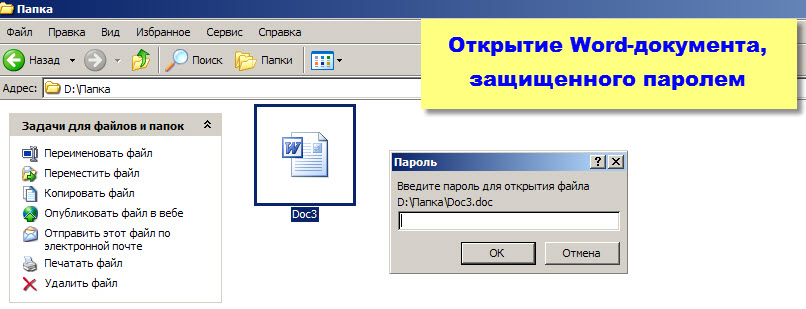
Do the same procedure in Microsoft application Word 2003 can be accessed through the “Tools” menu, then “Options”, then “Security”.
For Microsoft Word 2010, the path is as follows: the “Microsoft Office” button, then “Protect document”, then “Encrypt with password”.
How to remove a password previously set on a Word document?
In Microsoft Word 2007, open your Word document for which you previously set a password. Then follow the same path as to set a password - remember, the “Microsoft Office” menu, then the “Prepare” menu item, then “Encrypt document”. In the document encryption window that appears, delete the password you previously entered and click “OK.” After closing your Word document you will see program message about changes made to the document. Click "Yes". That's it - the Word document is no longer password protected. It can be freely opened by any user on a computer.
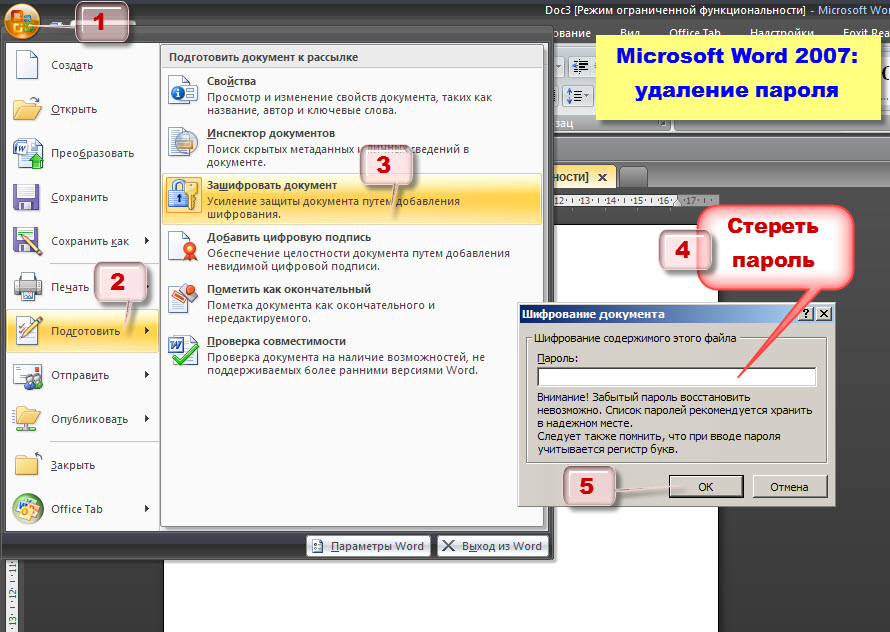
You can do the same procedure in Microsoft Word 2003 through the “Tools” menu, then “Options”, then “Security”, where previously set password must be removed from the “Password to open file” field.
For Microsoft Word 2010, the path is as follows: the “Microsoft Office” button, then “Protect document”, then “Encrypt with password”, where the previously set password must be removed from the document encryption window.
How to protect a Word document from changes?
Your situation may not require this. cardinal decision, like setting a password to open a Word document. For example, you don't need to hide its contents from prying eyes, but you would like to prevent changes to it - editing and formatting.
In Microsoft Word 2007, go to the “Review” tab, and then click on the “Protect Document” function. In the menu that appears in the sidebar, you can select the types of restrictions for your Word document - formatting restrictions, as well as editing restrictions. To apply restrictions, click the “Enable protection” command, then in the window that appears, enter the password you created and repeat it. Click “OK” - that’s it, your Word document is password protected from formatting and editing.
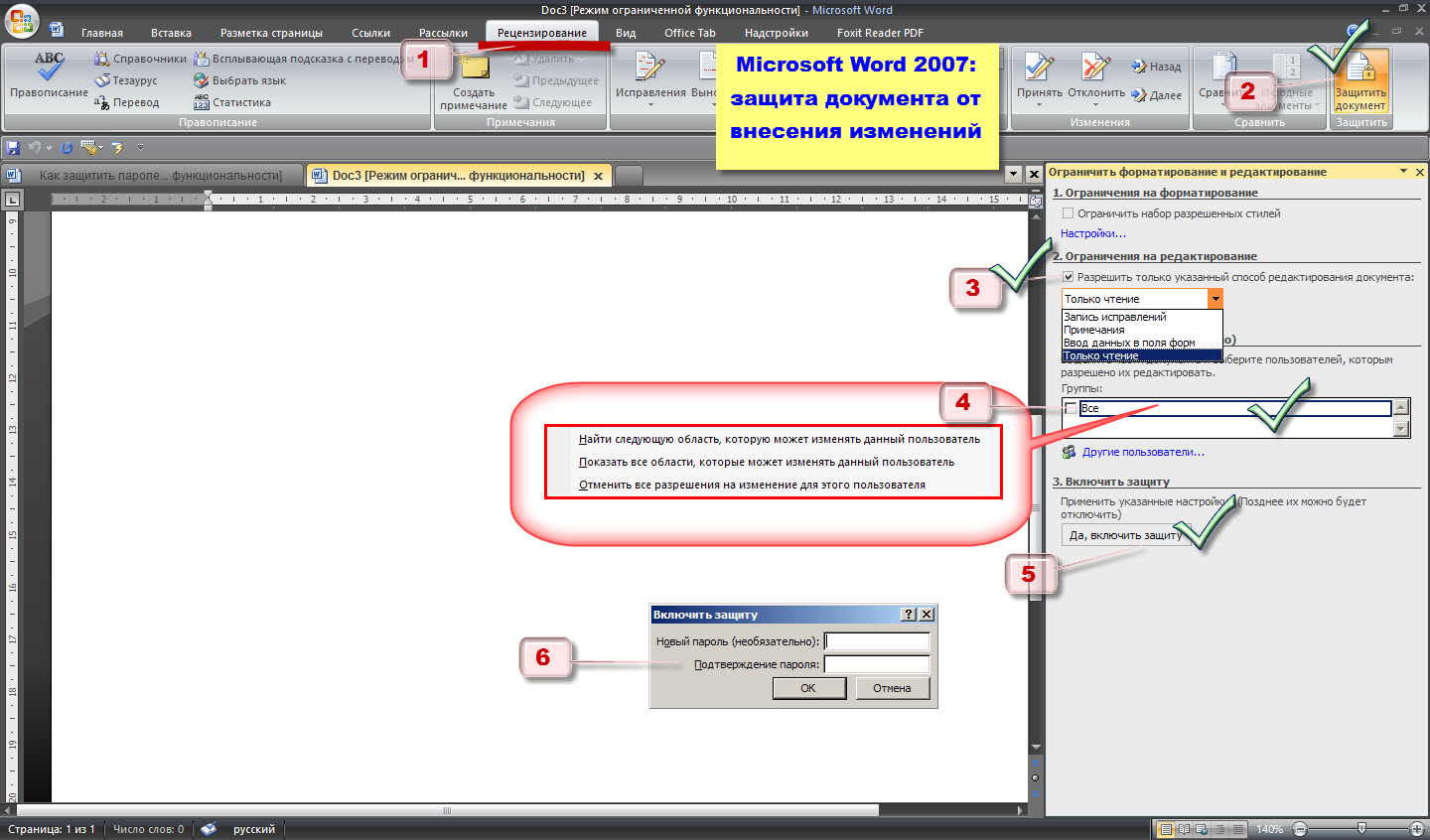
From now on, no matter how furiously another user wants to make changes to your Word document - add something, delete something, change the font or color, your document will respond that to do this, you must first disable its protection.
It's very easy to disable document protection from changes. Here, in the “Review” tab, again open the “Protect Document” function and click the “Disable Protection” command. Enter your password and that’s it – all restrictions on your Word document are removed.
You can do the same procedure in Microsoft Word 2003 through the “Tools” menu, then “Protect Document”.
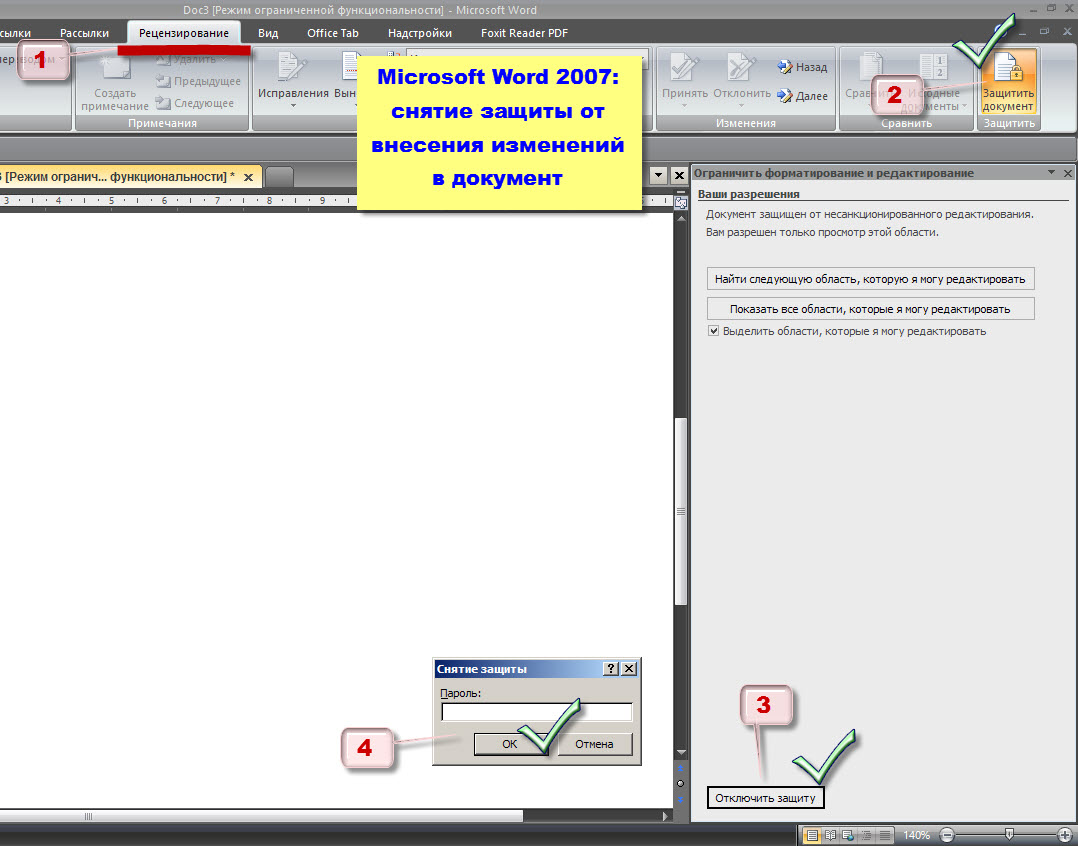
For Microsoft Word 2010, the path is as follows: the “Microsoft Office” button, then “Details,” then “Limit Editing.”
To sum it up...
As you can see, setting a password for a Word document is a fairly simple process that can be done in just a couple of clicks.
Microsoft Word has one rather strict feature in terms of setting passwords - the impossibility of recovery forgotten passwords. Unfortunately, if you forget the password for your document, Microsoft Word will not send it to you. email, SMS to mobile phone, even your mother’s maiden name won’t help... So be extremely careful. And just in case, keep the password for the Word document written down somewhere.
To organize a more reliable comprehensive protection your data on a computer that you have access to different users– family members, especially children, employees at work, use your personal (password-protected, of course) account Windows entry. Limit data to your personal account prevent users from viewing other operating system accounts.







